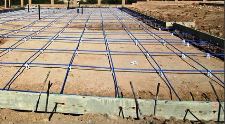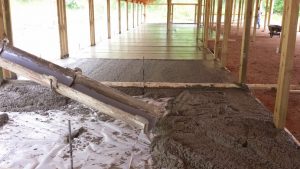Bob, one of our Building Designers, comes up with some truly great questions. I appreciate him keeping me thinking!
Today Bob writes, “Any reason why a client in Louisiana would not be able to have a post-tension slab installed in one of our buildings? Apparently it’s a slab suggested in his area because of the type of soil and the tendency for slabs to otherwise crack. Sounds like he could erect the posts and roof as usual, and before pouring install additional posts that would be only be used for the post-tension slab along with cables that they would tension before the pour.”
Even though concrete is a very rigid material, it has a natural weakness when it comes to tension. It is limited with respect to what length of floor can be made out of it. One way to be able to build these structures with longer spans than would be possible with ordinary concrete is through a technique called pre-stressing. A post-tension slab is a slab of concrete which has been pre-stressed using a specific method to increase the strength of the concrete.
Several methods exist for pre-stressing concrete, with post-tensioning being a very common one. Before a post-tension slab is poured, high-strength steel strands or cables, called tendons, are laid in a tight grid. These help support and give strength to the slab once it has cured. The tendons are sheathed in plastic so they do not directly touch the concrete. After the grid is made, the concrete is poured, with extra care taken to make sure the tendons remain at the correct depth.
 The concrete is allowed to cure to about 75% of the way, at which point post-tensioning occurs. Each of the tendons in the post-tension slab is pulled tight, using a hydraulic jack. The tensing of the cables occurs after the concrete has mostly cured, hence the term “post-tension.” The tendons are usually pulled to a tension of 25,000 pounds per square inch. Once the cables have reached the designated tension, they are anchored in the concrete, and the slab is allowed to fully cure.
The concrete is allowed to cure to about 75% of the way, at which point post-tensioning occurs. Each of the tendons in the post-tension slab is pulled tight, using a hydraulic jack. The tensing of the cables occurs after the concrete has mostly cured, hence the term “post-tension.” The tendons are usually pulled to a tension of 25,000 pounds per square inch. Once the cables have reached the designated tension, they are anchored in the concrete, and the slab is allowed to fully cure.
This method of pre-stressing concrete is especially useful in areas where the soil expands and contracts relative to weather conditions.
Using a post-tension slab rather than ordinary concrete often makes good economic sense. Because there is a smaller depth of concrete used to obtain the same end result, construction costs are reduced.
When the floor thickness is reduced, so is the weight of the structure. A lighter building means the cost of building the foundation is reduced.
The answer for Bob’s client – there is no reason to not have a post-tension slab in a post frame building.








I thought it was interesting that you mentioned that this is more cost efficient. I didn’t realize that this used less materials than the traditional method. I think that this could be really beneficial, especially for my father-in-laws heavy duty remodel.